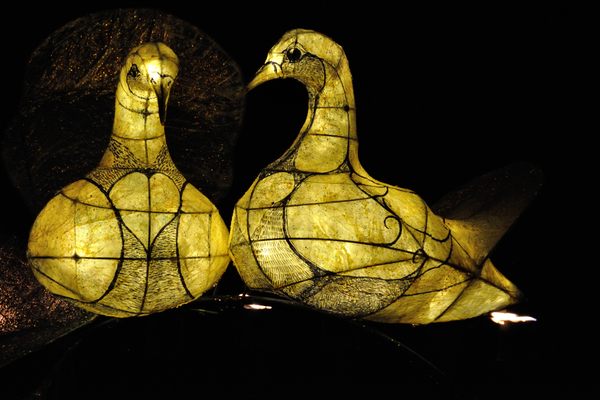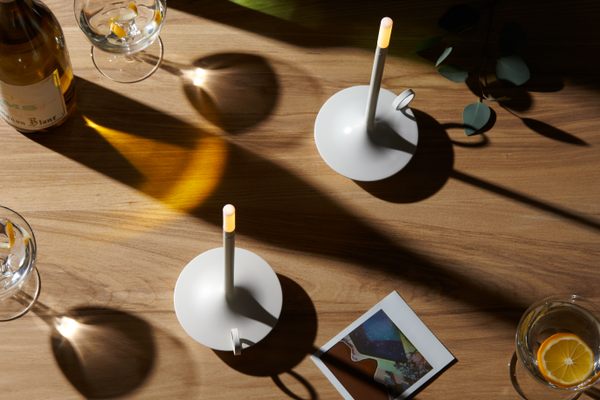
The Whimsical, Nostalgic Appeal of Becorns
A former Lego worker moved away from plastic and towards chipmunks.
A typical day in David Bird’s life begins with an idea for a story and then leads to scavenging through his backyard in Rhode Island for twigs, acorns, and pinecones. These foraged elements are the building blocks for his Becorns: woodland creatures that he brings to life with creativity, experience in toy design, and just the right amount of hot glue. Twigs become arms and legs, acorns pose as heads, petals decorate skirts, and mushrooms sit like hats.
Then it’s time to set the scene. Bird places the Becorn in his landscape of choice (usually around South Kingstown), arranges his camera on the tripod, and retreats inside his home, where he sits by the window with the camera’s remote control and a cup of tea, and waits.
If he’s lucky, something will scurry by within a couple of hours—a chipmunk or squirrel attracted by the seeds he’s left out for them. Bird will then capture the perfect shot of wildlife engaging with his Becorns.

That, however, is not always how it goes. Take Joonie, for example—a Becorn with a grassy scarf carrying a eucalyptus pod basket—whom he wanted to photograph feeding seeds to a cardinal. The neighboring wildlife unfortunately had a different plan, and the only shots Bird was able to get were of a mischievous squirrel dragging poor Joonie off into the woods.
It took more Joonies, a bunch of squirrel-chasing escapades, and four years’ worth of patience before he was finally able to take the photograph with a cardinal. Bird, however, takes the unexpected difficulties in stride.

“I have ideas about how it’s going to go, but inevitably a lot of other things happen that I can’t anticipate,” he says about his process. “So it’s a real collaboration with nature. That’s what makes it fun and exciting.”
When one of Bird’s instagram posts went viral, his followers shot up from 4,000 to 400,000 in just one week, proving that despite the hustle of everyday life, people still yearn for a return to nature—the more whimsical, the better. But Bird’s choice of building blocks wasn’t always twigs and leaves. His creative journey started years ago, across the Atlantic Ocean as a toy designer for Lego in Denmark.

Tell us about your time at Lego, and how it inspired your Becorns.
I graduated from Rhode Island School of Design (RISD) with a degree in Industrial Design, a strong interest in mechanisms and storytelling, and no idea about what kind of job could include all of those things. But then I interviewed with Lego in Denmark, which was the first time in my life that everything clicked. I got the job and found my stride in designing buildable action figures. I learned so much about character design, storytelling, and what triggers children’s imagination, which created the foundation of my Becorns.
I left Lego after about five years. It was a wonderful adventure, but I didn’t want to settle down in Denmark long-term. So I took a leap of faith, got a job designing medical equipment in my hometown in Pennsylvania, and moved back to the States.

What was the moment that led to the creation of your Becorns?
Shortly after leaving Lego, I was sweeping my mom’s driveway, wondering whether I’d made the right decision—and then spotted a branch that distinctly looked like a bug’s face. I looked down at the twigs and leaves, and had the sudden realization that I could still do exactly what I’d been doing at Lego. But this time, I’d create my own world.
From the very beginning, I knew this was something I wanted to share with the world, and photography—even though I knew very little about it—felt like the obvious way to do so. I started with a simple point-and-shoot camera, and gradually leveled up. But it still feels strange to call myself a professional photographer.

When did wildlife become part of your Becorns’ story?
I started building all sorts of different creatures until I created this acorn person, who felt like the perfect main character to build a world around. And of course, a squirrel would be the natural antagonist for an acorn person, so that’s why I brought in the wildlife aspect.
At the time, I was living in the city, so I began trekking out to the woods to be closer to nature. I sprinkled watered-down peanut butter wherever I’d set up my Becorn in the hopes of attracting some squirrels, and then waited. After several days of waiting, I finally got a picture of a blurry squirrel tale.
It wasn’t until I moved out of the city and took some photography classes that I was able to learn more about wildlife and stage my photoshoots correctly. For example, I noticed that hummingbirds flew to the trumpet creepers in our backyard about every 20 minutes, went to every single flower on the plant, and always approached from the same angle. Later on, that allowed me to set up both my Becorn and my camera in the optimal spot to take the perfect picture.

What’s the value of this kind of storytelling? What do you want people to feel when they see your Becorn photography?
There’s something universally appealing about an image that doesn’t just depict a subject, but truly has a story, heart, and hope to it. In truth, I stumbled onto this project by following my passion, but now I see that Becorns are so much more than a beautiful photograph—they can also be seen as a call back to nature. And now that I have kids, I appreciate anything that inspires children to go outside.
Some people have also told me that Becorns remind them of their childhood, when they felt a sense of wonder that as adults we tend to forget. They tell me that they feel something they haven’t felt in years, that they hadn’t realized they were missing. This feeling of nostalgia wasn’t my explicit intention, but creating a sense of wonder and an appreciation for nature certainly was, and I’m happy that my attempt to recapture my own childhood wonder takes others back to a time when everything seemed possible.






























Follow us on Twitter to get the latest on the world's hidden wonders.
Like us on Facebook to get the latest on the world's hidden wonders.
Follow us on Twitter Like us on Facebook